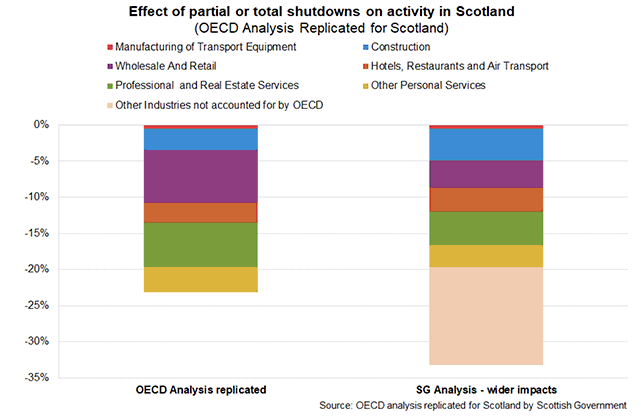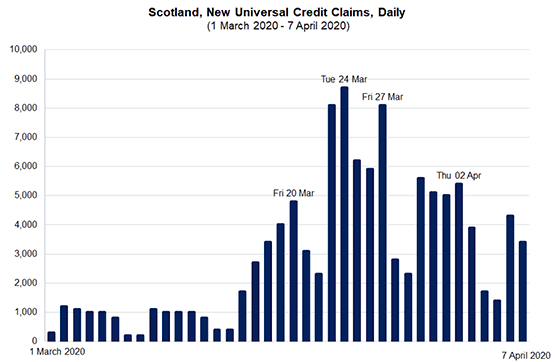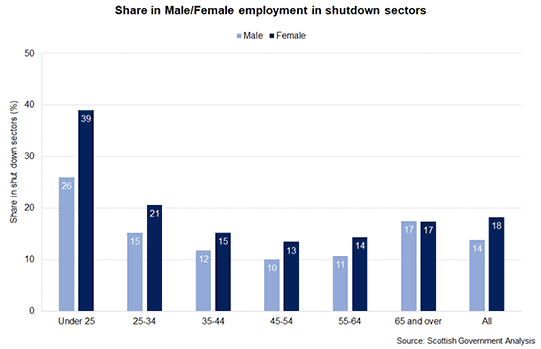Coronavirus (COVID-19): framework for decision making - supporting evidence
Analytical overview of the key analysis and evidence in support of COVID-19: framework for decision making - further information, summarising data and evidence on the various harms and wider impacts caused by the crisis.
This document is part of a collection
6. Economic impacts
The economy is central to our wellbeing in Scotland whether it is through the provision of direct services and goods, provision of taxes to fund public services like health and welfare, or by providing direct opportunities for employment and income.
Our business base is diverse and there are many individuals and households across Scotland that form part of it and they are providing goods and services for local communities as well as to international markets. The impact of COVID-19 has materially changed how we interact with the economy daily and will reset many of these key interactions going forward.
Dimensions of economic harm
The dimensions of economic harm include the direct impact on the economy and are inter-related to health and social harms through the indirect effects that a weaker economy can have on health and society through, for example, the impact of unemployment. The scarring in terms of social and health effects will come via the longer recovery period as we deal with the impacts of higher unemployment and financial insecurity and hardship for many businesses, individuals and households. The damaging effect on poverty and inequality may be profound.
There will also be gender and age-related dimensions of economic harms that are important to consider as different groups in society will be impacted in different ways depending, for example, on their labour force participation and on where they live.
The extent to which the economy can restart is another important consideration. As measures are lifted and as business and society reopen, we will see a reversal of the output contraction for many parts of the domestic economy. However, not all sectors will come back immediately - or to the same extent - as external demand, consumer demand and business models will have changed significantly.
The time dimension is important too as the economic harm from physical distancing measures is not static nor linear. The impacts will intensify the longer the lockdown continues: we will see more businesses unable to recover and we risk the scarring effects of unemployment. This will then feed through to increasing the health and social harms.
The direct COVID-19 harm is key to the level of economic harm we may see. The lower the direct COVID-19 harm is at a point in time, the greater the signal to businesses that, consistent with our guidance and regulations, it is safe to re-open and the more consumer demand is likely to pick up. Decisions to change restrictions sooner would enable the economy to re-start but there is also the risk that if restrictions are changed too soon and the direct COVID-19 harm increases then some physical distancing measures may have to be re-introduced and this could lead to further economic harm.
Evidence on economic harms[26]
The priority has been to protect public health with physical distancing measures quickly introduced to contain the spread of COVID-19. Some of these measures have necessitated the shutdown of many parts of the Scottish economy.
Our analysis shows that 22% of the economy is strictly closed which has impacted over 900 thousand jobs and over one third of the business base (including the self- employed).
We estimate a 33% fall in GDP if the current distancing measures were to be in place for three months (see Figure 15). Over the year this equates to a 12% decline in GDP. These estimates are similar to those produced by the OECD as well as other organisations such as the Office for Budget Responsibility.

The contraction in economic activity is steeper and faster than in previous downturns and it has similarly impacted our major trading partners. The latter means many of our external markets both for goods and supplies are also impacted. The sudden cessation of economic activity has focused the economic policy response on maintaining productive capacity, which in many cases has meant supporting temporarily closed businesses.
It is important however to recognise that this is no ordinary economic downturn: many productive, profitable and sustainable businesses have been required to temporarily close bringing immediate financial stress. The policy response to the pandemic has also been unprecedented with a combination of fiscal, monetary and macro-prudential measures to maintain cashflow, incomes, wages and employment across the economy - reflecting both the indiscriminate nature of the crisis and the need to protect productive capacity.
We are also starting to see the impacts on the labour market with estimates from the Office of National Statistics showing that around one fifth of workers UK wide are currently furloughed through the Coronavirus Job Retention Scheme. Figures for Scotland are not currently available.
Although recent labour market figures do not yet capture the effects of COVID-19, we are seeing a significant rise in those applying for universal credit which suggests that we may soon see a big increase in unemployment. Figure 16 shows a sharp rise in new universal credit claims in Scotland since the period of lockdown began and policy support packages were put in place.

Our analysis (see Figure 17) shows the shutdown will hit younger workers the hardest as employees aged under 25 are more likely to work in a sector that has shut down as other employees. Women are more likely to work in a sector that has shut down than men. This highlights the gender and age-related dimensions of economic harms.

Source: Annual Population Survey Jan-Dec 2019, ONS
Contact
Email: CovidExitStrategy@gov.scot
There is a problem
Thanks for your feedback